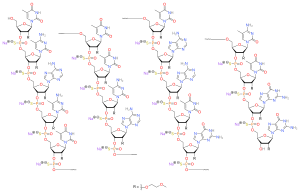Nusinersen
 |
|
| Clinical data | |
|---|---|
| Trade names | Spinraza |
| ATC code |
|
| Legal status | |
| Legal status |
|
| Pharmacokinetic data | |
| Metabolism | Exonuclease (3’- and 5’)-mediated hydrolysis |
| Biological half-life | 135–177 days (in CSF), 63–87 days (in plasma) |
| Identifiers | |
|
|
| Synonyms | IONIS-SMNRx, ISIS-SMNRx |
| CAS Number | |
| DrugBank | |
| ChemSpider | |
| UNII | |
| KEGG | |
| Chemical and physical data | |
| Formula | C234H323N61Na17O128P17S17 |
| Molar mass | 7501 Da |
Nusinersen (INN), marketed as Spinraza, is the first drug approved by the U.S. Food and Drug Administration for use in treating spinal muscular atrophy (SMA), a rare neuromuscular disorder. It is a biologic drug that binds to mutated RNA.
The drug is used to treat spinal muscular atrophy associated with a mutation in the SMN1 gene. It is administered directly to the central nervous system (CNS) using intrathecal injection.
In clinical trials, the drug halted the disease progression. In around 60% of infants affected by type 1 spinal muscular atrophy, the drug also significantly improved motor function.
Like other antisense drugs, there is a risk of abnormalities in blood clotting and a reduction in platelets as well as a risk of kidney damage.
In clinical trials, people treated with nusinersen had an increased risk of upper and lower respiratory infections and congestion, ear infections, constipation, aspiration, teething, and scoliosis. One infant in a clinical trial had severe lowering of salt levels and several had rashes. There is a risk that growth of infants and children might be stunted. In older clinical trial subjects, the most common adverse events were headache, back pain, and adverse effects from the spinal injection.
Some people may develop antibodies against the drug; as of December 2016 it was unclear what effect this might have on efficacy or safety.
Spinal muscular atrophy is caused by loss-of-function mutations in the SMN1 gene which codes for survival motor neuron (SMN) protein. Patients survive owing to low amounts of the SMN protein produced from the SMN2 gene. Nusinersen modulates alternate splicing of the SMN2 gene, functionally converting it into SMN1 gene, thus increasing the level of SMN protein in the CNS.
...
Wikipedia
